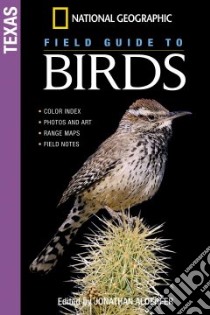National Geographic Field Guide to Birds - 9780792241874
Un libro in lingua di Alderfer Jonathan K. (EDT) edito da Natl Geographic Society, 2005
- € 13.90
- Il prezzo è variabile in funzione del cambio della valuta d’origine
This series of pocket-size bird field guides began with the launch of the first two guides: California and Florida in Spring 2005, followed by the Summer 2005 Titles: New Jersey and Michigan.
The new Fall 2005 titles take you to The Carolinas and Texas. In the Texas guide, users will find the richest possible range of birds-mostly migrants!-as Texas is the ultimate migration ground, drawing birds from around the world. The range from magnificent raptors to tiny, yet hearty terns, to delicate wrens will surprise and delight. The Texas range maps will focus on the migration routes and best time of year to see the migrants, some traveling from as far away as the Antarctic.
Future titles will include: Alaska, The Rocky Mountains, East Coast Canada, Oregon, Pennsylvania, and the Great Plains.
The books are designed for use by novices to experienced birders who want to take only the guide for the state or region they're visiting.
Each guide is 272 pages and features about 175 birds-either as a main entry or secondary entry
Their handy trim is 4x6 and can easily fit in a backpack or pocket for easy access. Rather than alphabetically, the birds are featured by family, as supported by the American Ornithological Association. (A quick reference alphabetical guide on the inside of the back cover helps you find a bird quickly.)
The following points make these books the ultimate area guides to birds:
Introduction: By an expert birder in that region gives focused guidance on how to look for the top birds in this region, where to look for them, and what to focus on when you see them.
How-To-Use: This 4-page entry is two-fold. It reveals the basic makeup of a bird, so users will become familiar with the bird parts and lingo in this and any guidebook; it also has how-to-use instructions with a keyed spread.
125 Easy-to-use Entries. The clean, straightforward layout makes it a snap to identify birds in the field:
1.Each entry has a vivid photograph on the left page showing the bird in its habitat.
2.On the right page is a list of bulleted points called field identification clues
3.Then 3 main entries are: Behavior, Habitat, Local Sites.
4.At the bottom of each entry a "Field Note" gives an additional highlight to look for in the bird's behavior. Many of these are illustrated by
5.Secondary birds (about 25 per book) are featured in artwork next to the field fact.
Several features work together to make this the ultimate beginning birder's tool:
*A full index with boxes for beginners to start marking their life list.
*In many volumes a Field Notes page for individual notes on where birds were sighted or features to look for.
*The alphabetical, quick-reference field index on the back inside cover,
*A color-coded index, which features drawings of birds by color, with page number- the best possible cross-referencing tool to put early birders on the track to lifelong birding.
Informazioni bibliografiche
- Titolo del Libro in lingua: National Geographic Field Guide to Birds
- Sottotitolo: Texas
- Lingua: English
- Autore: Alderfer Jonathan K. (EDT)
- Editore: Natl Geographic Society
- Collana: Natl Geographic Society (Paperback)
- Data di Pubblicazione: 01 Ottobre '05
- Genere: NATURE
- Argomenti : Birds Texas Identification
- Pagine: 272
- Dimensioni mm: 146 x 101 x 12
- ISBN-10: 0792241878
- EAN-13: 9780792241874


